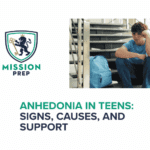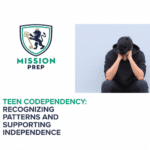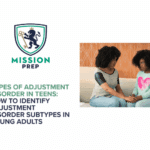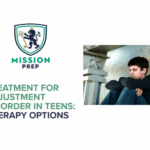Dissatisfaction With Life in Teens: Signs, Triggers, and Coping

Unfortunately, teen dissatisfaction with life is common and is closely tied to depression and other mental health disorders in adolescence.1 Plus, without treatment, these conditions can worsen, further impacting dissatisfaction with life in teens.
If a teenager is showing dissatisfaction with life or signs of teen depression, professional mental health support can provide valuable guidance. This page can also help you better understand teen dissatisfaction with life, as it explores:
Causes of teen dissatisfaction with life- Signs of emotional struggles in adolescence
- Mental health disorders and chronic unhappiness
- Where to find help for teen emotional issues

Causes of Life Dissatisfaction in Teens
Let’s explore these factors in more detail:
Interpersonal Stressors
Interpersonal stressors relate to peers, friends, and romantic relationships, and these play a major role in teenage wellbeing and mental health.2 When teenagers feel supported and accepted by their peers, their confidence and sense of belonging grow, and they usually feel more satisfied with life. By contrast, teens who report feeling lonely or excluded by peers tend to report lower life satisfaction.3
Family dynamics can also play a part in teen dissatisfaction with life. When teenagers feel restricted or believe their parents don’t trust them, it can contribute to mental health teenage frustration.3
Coping mechanisms for interpersonal stressors can include both adaptive and maladaptive behaviors. However, relying on maladaptive behaviors for coping with teenage stress often leads to greater dissatisfaction in life.3
School Stressors
Academic pressure can also contribute to chronic unhappiness in teens. Performing well at school and feeling comfortable in the learning environment can have a positive effect on mental health.3 This means that both students with high academic achievements and those who feel supported by teachers and peers generally have a greater sense of well-being.1,3
However, when students feel like they cannot cope with academic pressure or meet increasing demands, their life satisfaction tends to decline.2 Likewise, teens unhappy with school environments or who have poor relationships with their teachers are also generally less satisfied with life.2 In these situations, studies suggest that teen counseling for school problems can improve both academic performance and overall life satisfaction.1
Physical and Mental Health
How teenagers perceive their bodies and their overall physical health also has a major impact on life satisfaction.3 Specifically, in female teenagers, unhappiness with weight or body image is closely linked to life dissatisfaction.
Teens who experience frequent tiredness, low activity levels, or poor physical, mental, or oral health also report a lower sense of well-being.3 This suggests that healthy lifestyle habits such as exercise, nutrition, and rest are essential for maintaining a positive mood and improving overall life satisfaction.
Personality Traits
Studies examining adolescent personality consistently show that certain traits are closely linked to how satisfied young people feel about their lives. In particular, research highlights that teens who experience more positive affect, meaning frequent positive emotions such as optimism, joy, and enthusiasm, and higher self-esteem, generally report better life satisfaction.3
Researchers also use the five-factor model of personality to explain how certain traits can either support or undermine a teen’s sense of life satisfaction. In particular, high levels of neuroticism, or emotional instability, are found to be linked to dissatisfaction.4 This is due to the close ties between neuroticism and anxiety, hostility, depression, self-consciousness, impulsiveness, and vulnerability.4
In contrast, high levels of extraversion are linked to higher levels of life satisfaction.3,4 Extraversion is a social measure composed of several factors, which include warmth, gregariousness, assertiveness, activity, excitement-seeking, and positive emotions.4
Understanding the internal and external causes of teen dissatisfaction with life is important for devising effective solutions. No one wants to see their child struggle, so it’s vital to strengthen the protective factors explained above while reducing the risk factors that contribute to distress.
Signs of Emotional Struggles in Adolescence
Some of the most common warning signs include:
Problems in school- Withdrawal
- Loss of interest in regular activities
- Frustration
- Self-esteem issues in teens5
When it comes to school, you may notice your teen struggling academically or their motivation dropping below what is typical for them.5 Socially, they may begin to spend less time with their friends or avoid family time or occasions. If your child usually takes part in sports, art, reading, or other hobbies or extracurricular activities, take notice if they stop participating or say these things no longer make them happy.
As school and interpersonal stressors build, many teens start to worry about the future or feel like they’re not good enough.1,2 Plus, early red flags of self-esteem issues in teens can include negative self-talk, self-blame, or social withdrawal. 5
Keeping track of these behavioral changes in teens can help you catch emotional struggles early and take timely measures to prevent a worsening situation.
Mental Health Disorders and Chronic Unhappiness
Depression:
Major depressive disorder (MDD) is the most common and widely studied mental health disorder in adolescence.1,3,7 In fact, one study from 2016 found that around 12% of US children aged 12-17 experience at least one major depressive episode during adolescence.6
Teens with depression often show ongoing sadness, hopelessness, or irritability that affects school and relationships. Being diagnosed with MDD in adolescence also increases the chances of suicide later in life.5 Common predictors of suicide in teens include self-injury, a previous suicide attempt, family problems, use of drugs and alcohol, and a history of abuse.5 Studies also show that female teens show higher rates of depression and suicidality than males.5
Anxiety:
Anxiety disorders are also common in adolescence, and they are closely linked to life dissatisfaction.7 Studies estimate that 5-10% of children ages 6-18 meet the diagnostic criteria for an anxiety disorder.8 Furthermore, anxiety disorders and depression tend to be related; many teens diagnosed with an anxiety disorder also meet criteria for depression or another mood disorder. An anxiety disorder diagnosis in adolescence can also be a predictor of the development of eating disorders.8
Eating Disorders:
Additionally, teens with eating disorders often report lower life satisfaction and lower self-esteem than peers.9 The three main eating disorders identified in the DSM are anorexia nervosa (AN), bulimia nervosa (BN), and eating disorder not otherwise specified (EDNOS). However, there are also different subtypes that parents and treatment providers need to be aware of.9
For example, the DSM-5 identifies atypical anorexia nervosa, which shows the same symptoms as anorexia nervosa but without a low body weight.9 Binge eating disorder, purging disorders, and midnight eating syndrome are also recognized as serious health concerns in adolescence.9
While we have focused here on the three most common disorders related to teen dissatisfaction with life, other conditions, such as ADHD, trauma, and substance use, can also cause severe emotional struggles in adolescence.
Help for Teen Emotional Issues
Cognitive Behavioral Therapy (CBT) is usually the first-line approach for adolescent depression because of the strong evidence supporting its effectiveness.6 CBT focuses on problem-solving, stress management, and changing negative thinking patterns.6 It is also widely used in the treatment of anxiety disorders and eating disorders in adolescents.8,10
CBT-E is the subtype of CBT tailored specifically towards treating eating disorders in adolescence, and therapists often adjust the program to suit the unique needs of younger patients. These changes may include increased parental involvement, helping the teen understand the need for change, and lowering the threshold for inpatient care due to potentially dangerous physical symptoms.10
When appropriate, medication can also be helpful in treating emotional struggles in adolescence. Selective serotonin reuptake inhibitors (SSRIs) are one class of medication commonly used to manage symptoms of depression,5 anxiety,8 or certain eating disorders.11 Examples of SSRIs most often prescribed to teens with emotional struggles are fluoxetine (Prozac), escitalopram (Lexapro), sertraline (Zoloft), and fluvoxamine (Luvox). Importantly, studies show that combining medication therapy with CBT can lead to better treatment outcomes.5,8,10
Finding the right mental health treatment may take time, but it is crucial for helping your teen regain confidence and stability.

Mission Prep: Providing Mental Health Programs for Teens
At Mission Prep, we are here to support parents and teens through every stage of recovery. We offer a wide range of mental health treatment options to ensure the right approach for specific needs.
For many families, our outpatient CBT program can help address teen emotional issues early and build long-term coping skills. When a higher level of care is needed, we also provide residential care in our inpatient treatment centers in California and Virginia.
If you’ve been searching for “teen therapy near me” or aren’t sure which treatment option is right for your child, call Mission Prep today. We’ll take time to understand your situation, answer any questions you have, and recommend the most effective path forward for your family.
References
- Moksnes, U. K., Løhre, A., Lillefjell, M., Byrne, D. G., & Haugan, G. (2016). The association between school stress, life satisfaction and depressive symptoms in adolescents: Life satisfaction as a potential mediator. Social Indicators Research, 125(1), 339-357. DOI 10.1007/s11205-014-0842-0
- Moksnes, U. K., & Haugan, G. (2015). Stressor experience negatively affects life satisfaction in adolescents: the positive role of sense of coherence. Quality of Life Research, 24(10), 2473-2481. DOI 10.1007/s11136-015-0977-8
- Kekkonen, V. I. R. V. E., Kraav, S. L., & Tolmunen, T. O. M. M. I. (2020). Predictors of life satisfaction in adolescence and from childhood to young adulthood. Psychiatria Fennica, 52, 68-77. https://www.researchgate.net/publication/348442602_PREDICTORS_OF_LIFE_SATISFACTION_IN_ADOLESCENCE_AND_FROM_CHILDHOOD_TO_YOUNG_ADULTHOOD
- Suldo, S. M., Minch, R. D., & Hearon, B. V. (2015). Adolescent life satisfaction and personality characteristics: Investigating relationships using a five factor model. Journal of happiness studies, 16(4), 965-983. DOI 10.1007/s10902-014-9544-1
- Mehler-Wex, C., & Kölch, M. (2008). Depression in children and adolescents. Deutsches Arzteblatt international, 105(9), 149–155. https://doi.org/10.3238/arztebl.2008.0149
- Mullen, S. (2018). Major depressive disorder in children and adolescents. Mental Health Clinician, 8(6), 275-283. DOI: 10.9740/mhc.2018.11.275
- Hoseini-Esfidarjani, S. S., Tanha, K., & Negarandeh, R. (2022). Satisfaction with life, depression, anxiety, and stress among adolescent girls in Tehran: a cross sectional study. BMC psychiatry, 22(1), 109. https://doi.org/10.1186/s12888-022-03757-x
- Rapee, R. M., Creswell, C., Kendall, P. C., Pine, D. S., & Waters, A. M. (2023). Anxiety disorders in children and adolescents: A summary and overview of the literature. Behaviour Research and Therapy, 168, 104376. https://doi.org/10.1016/j.brat.2023.104376
- Pelc, A., Winiarska, M., Polak-Szczybyło, E., Godula, J., & Stępień, A. E. (2023). Low self-esteem and life satisfaction as a significant risk factor for eating disorders among adolescents. Nutrients, 15(7), 1603. https://doi.org/10.3390/nu15071603
- Dalle Grave, R., & Calugi, S. (2020). Cognitive behavior therapy for adolescents with eating disorders. Guilford Publications. DOI: 10.32044/ijedo.2022.01
- Horovitz, O. (2025). Advancements in the Diagnosis and Treatment of Eating Disorders in Children and Adolescents: Challenges, Progress, and Future Directions. Nutrients, 17(10), 1744. https://doi.org/10.3390/nu17101744



















